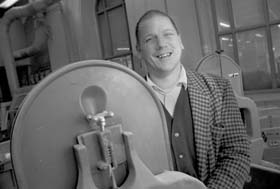
Jon Rousham: Stern and supportive
Jon Rousham walks a fine line in the fine dust covering everything in the School of Architecture lab. As the lab's senior and only technician, he has the sometimes misunderstood task of ensuring that architecture students design well for the materials they choose and build well with the wood, metal and cement available in the high-ceilinged facility. And that they do it unscathed.
Safety has been Rousham's prime concern since he assumed his post five years ago. Until last year, at least one student per year would leave the Macdonald-Harrington building in an ambulance thanks to injured, though never completely severed, fingers.
For the past one and a half years, though -- "touch wood," as he says ironically -- there's been not a single serious injury.
Cutting down on accidents was a chief goal for Rousham and he is strict with students when it comes to safety. "Only those students who really know what they're doing are allowed to use the table saw."
Knowing what one is doing is a fairly rare trait in first year architecture students, says Rousham, who qualified as a carpenter at the tender age of 21, and who has worked in design and building ever since. He estimates that only one in 50 begins with any building skills.
That fact, however, does not prevent some students from having confidence in themselves far exceeding their ability, notes Rousham.
Trained in Britain, the Chicoutimi-born Rousham treasures the high standard of work and the accompanying humility that the master carpenter he apprenticed under passed on to him. And that's something he tries to pass on to his students, frequently sending them back to the drawing board when the design doesn't fit the materials or the function. "That's where I've got this 'bad guy' reputation when I send them back, saying 'This isn't going to work,'" says Rousham.
He learned to take life seriously at a young age. He became a father, husband and homeowner all by the age of 19. Now on his fourth house -- a triplex on the Plateau that he renovated -- and his second child, 16-month-old Samantha, who is a frequent visitor at the lab -- Rousham continues to be serious, still maintaining a design and construction firm for after hours.
While he has at times worried about being too hard on the students -- coming from the tough-nosed construction sector, being sensitive was a lesson to be learned, he acknowledges -- Rousham concludes: "I couldn't justify staying here and calling myself a teacher if I didn't go all the way."
That's an attitude in Rousham that architecture professor Ricardo Castro, who teaches the second-year studio course, appreciates. "Students have poetic ambition and Jon adds pragmatics to make their dreams come true."
Teaching was an opportunity he leapt at six years ago when an opportunity opened up to run the industrial design workshop at Carleton University for a year. A break from construction, plus the opportunity to pass on his skills as well as learn new ones, such as metal working and teaching, proved irresistible to Rousham. As luck would have it, McGill's School of Architecture was looking for a lab technician just as the Carleton position was ending.
What he most enjoys in the job is the diversity of tasks. "I'm exposed to a wide variety of people and ideas. After being in construction for 15 years, it was great to have stimulating discussions."
Ironically, Rousham's first love was architecture. After leaving the family home in a fit of rebelliousness at age 17, he ventured to Europe, where, while volunteering on the renovation of a chateau in France, he discovered his love of wood and building. In England, he began architecture studies but soon realized that as an architect he was bound for desk-work which was not his cup of tea. Carpentry, on the other hand, allowed him the freedom to build and design.
Now, he reckons he has the best of both worlds and appreciates being in a position where he can help students value the wealth of resources at their disposal. "Because of not having gone to university, I can appreciate this environment where you are encouraged to ask questions and you know there is a broad range of people to answer them," says Rousham, adding that there isn't that luxury of time and accessible expertise in the work world.
Bronwyn Chester
| 


